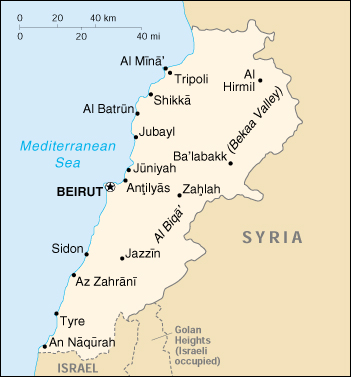

Status Quo Side: Christians
Non-Status Quo Side: Muslims
Region: Middle East
Conflict Type: External Intervention
Issues in Dispute: Ethnic Governance
Religious and political divisions [see LEB] were magnified by income inequities and the failure of the dominant Christians to update the 1932 census (the basis for the allocation of power) in favor of faster-growing Muslims. Egypt, Iraq and Libya increased support for Muslim factions, while the Maronites (largest Christian sect) anticipated US and Israeli support despite US denials. Anti-Israeli terrorist attacks from Lebanese bases increased after the 1970 PLO expulsion from Jordan. Israeli retaliations further alienated leftist Muslims from rightist Maronites and undermined governmental legitimacy, with 9 changes in 3 years.
Full-scale civil war erupted between leftist Muslims (with PLO aid) and conservative Christians. Syrian pro-Christian forces imposed an October 1976 cease-fire, but conflict continued near the Israeli border. In 1977 Israel's Likud government increased support for its surrogate Phalangist Maronite militia, establishing a "security zone" in S.Lebanon despite the presence of UN peacekeeping force (UNIFIL). Warfare continued within Phalangist and Camille Chamoun's NLP groups on the right, and within Palestinian factions. Syrian troops clashed with all, and in 1979 Israeli and Syrian jets dueled. By mid-1981, 53 private armies were operating. US and other cease-fire efforts had fleeting impact. In June 1982 Israeli troops invaded, bombed Beirut and cut off food and water. A Western multinational force monitored the evacuation of the PLO in August. On September 14, the Maronite President-elect Bashir Gemayel was assassinated, whereupon right-wing Phalangist Christians, given access by the Israelis, massacred over 400 Palestinians remaining in the Sabra and Shatilla refugee camps. Bashir's brother Amin Gemayel was elected President. A second Western multinational force sent to Beirut failed to restore government authority. The US, seeking to protect 1000 US marines, bombarded Muslim positions. In 1984, after US and French contingents were bombed by pro-Iranian Shi'ites, US forces were withdrawn. Kidnappings of foreigners and Lebanese increased. Israeli troops withdrew in February 1985 (except from the security zone), and French troops in 1986. UNIFIL remained, now with Soviet support. Despite a peace agreement signed between the Druse, Amal and moderate Christian Forces, clashes continued.
In September 1989, following one of many Arab League-sponsored cease-fires, 63 of the 73 surviving members of the 1972 Parliament met at Taif, Saudi Arabia, and in October agreed on a plan for a new constitution increasing Muslim representation and accepting a special Syrian relationship. On November 4 Christian General Michel Aoun, who had been interim prime minister, declared Parliament dissolved, but Elias Hrawi, also a Christian, was elected president under the Taif constitution.
In October 1990 Hrawi with Syrian help forced Aoun and his forces to surrender, bringing the civil war to an end.
Hizbullah rocket attacks, alternating with Israeli air strikes and in March 1996 a substantial Israeli incursion, kept the situation fluid in the security zone. By mid-1998 Israel was increasingly fed up with continuing casualties, and continued to hint at withdrawal in exchange for tranquility on its northern border. But Syria made it clear that the package must also include Israeli withdrawal from the Golan Heights, which Israel's Likud government rejected.